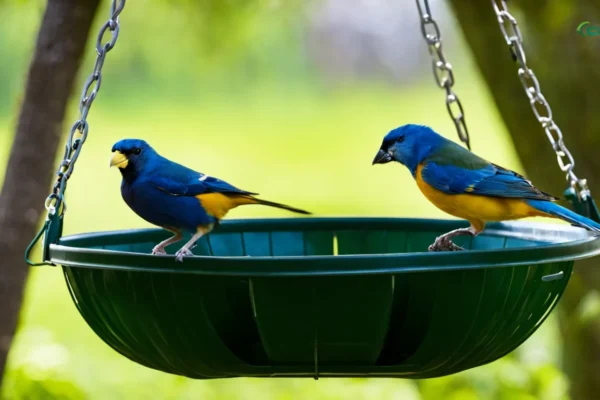Many birds’ diets often include grasshoppers and crickets, especially during the mating season. When rearing their young, even birds that do not typically consume insects may include grasshoppers and crickets in their diet since they are an excellent source of protein. But what are the advantages of eating grasshoppers for birds, and how can they capture these long-legged, springy insects?
It is known that over 200 different bird species use grasshoppers as food for their young and themselves. Crickets and grasshoppers are easily found, high-energy food sources that provide essential proteins for normal development and growth.
About 50–70% of grasshoppers are made up of protein, which is an essential resource for the early, fast growth of nestlings.
They are also prevalent in many natural settings and rather common around the globe. Another advantage for birds is that, unlike bigger prey, grasshoppers and crickets are very simple to catch and do not need a significant amount of energy to capture.
Though many farmers and gardeners see grasshoppers as devastating pests, they really serve an important function in their local environments as both consumers and prey for several bird species, which helps to regulate vegetation and promote biodiversity.
Continue reading to find out more about why grasshoppers are considered a superfood by many birds!
Grasshoppers’ Place in Bird Diets
Grasshoppers are an important part of the food of many bird species, including crows, hawks, owls, and songbirds. Some people eat grasshoppers year-round, while others only introduce them during the mating season, when large amounts of additional nutrients are required.
Chitin is an essential protein that supports the growth and development of juvenile birds and is abundant in the hard exoskeleton of grasshoppers. For birds that build nests, grasshopper fats are another beneficial source of energy.
Grasshopper-Eating Bird Species
For grassland birds, grasshoppers make about 30 to 90 percent of their diet. During the mating season, the proportion of birds that consume grasshoppers peaks; for instance, nestlings of Chestnut-collared Longspurs are fed over 70% grasshoppers as food.
Birds that consume grasshoppers, such as Northern Cardinals, Blue Jays, American Robins, Starlings, Sparrows, Warblers, and Bluebirds, gain from their high protein content.
When feeding their hungry nestlings, big bird species such as hawks, gulls, meadowlarks, and kestrels have been seen to consume about 100 grasshoppers each day in places where grasshopper populations are plentiful.
Digging Another animal whose young depend significantly on grasshoppers is the owl. During the nesting season, parents often feed their young owlets small animals. But as soon as they emerge from their burrows to hunt for their own food, they hunt and catch a lot of grasshoppers while honing their hunting skills.
Crows will consume grasshoppers, but generally only during protracted dry spells when there aren’t as many other food options.

How Grasshoppers are Hunted by Birds
Because grasshoppers are often solitary insects, it is easy to identify and capture them due to their size.
Many birds adopt sit-and-watch tactics, then attack or swoop in to pluck their targeted prey from the foliage. Many grasshoppers are collected early in the day before they have warmed up and become completely active because they struggle to move in chilly temperatures.
Flycatchers have the ability to sally, meaning they watch the grasshoppers as they go from plant to plant and then jump at them when they are in the air.
To search for grasshoppers, other birds, especially wrens, may use their tiny beak to raise bark and pierce underneath it.
The Loggerhead Shrike is one species that has a very interesting technique to eating grasshoppers. After catching grasshoppers and crickets, shrimpes impale them on prickly twigs or even barbed-wire spikes. Once they have accumulated a cache, they return and devour the insects one at a time, sometimes beheading them. They remove the deadly lubber grasshopper’s thorax before eating it, making them the sole known predators of the species. As a result, no poison should be consumed.
A loggerhead prawn is shown. After catching grasshoppers and crickets, shrimpes impale them on prickly twigs or even the spikes of barbed wire.
The Effect on the Environment
In the ecosystems in which they reside, birds and grasshoppers play crucial roles in nutrient cycling, crop protection, habitat maintenance, and pesticide use reduction. They also enhance biodiversity.
Several bird species are important in managing grasshopper populations and limiting excessive damage to crops and other plants because they prey on grasshoppers and crickets, especially in the spring and summer when they nest. Grasshoppers, on the other hand, aid in the breakdown of organic debris and assist in the eradication of undesirable vegetation.
The effects on ecosystems are thought to be potentially disastrous if birds stopped eating grasshoppers. Without birds to naturally regulate grasshopper populations, the insects might see a sharp increase in population, which would soon cause widespread devastation of plants, flowers, and habitats that are essential to other animal species.
Grasshopper-Eating Bird Attraction Strategies for Your Garden
One way to turn your garden into a grasshopper sanctuary is to reduce upkeep and cease mowing. Grasshoppers are drawn to untamed vegetation with tall grasses and weeds. Grasshoppers may find cover, nesting grounds, and food sources among a variety of tall grasses.
As many aspirational gardeners can attest, planting agricultural crops is another certain method to attract grasshoppers to your garden. Their favourite crops include onions, beans, and lettuce.
In the image is an Eastern Bluebird. Long grasses and weeds seen in natural vegetation are very appealing to grasshoppers.
Why Don’t Certain Birds Consume Grasshoppers?
While many birds will happily consume grasshoppers, either year-round or just during the mating season, certain species will not be attracted to the crunchy insects.
It seems improbable that hummingbirds would choose a grasshopper over the delicious nectar found in feeders or flowers, nor do ducks, geese, and other waterfowl naturally consume the long-legged insects.
An Annas Hummingbird is seen. Hummingbirds are unlikely to choose a grasshopper over delicious nectar from a feeder or flower.
Final Thoughts
Grasshoppers are an essential part of many juvenile birds’ diets in their early years and provide a variety of bird species with critical sources of protein and other nutrients.
Many birds seeking a fast and wholesome meal find grasshoppers to be the best choice of prey because of their abundance in grasslands across the western hemisphere and the little energy required for a successful capture. When feeding hungry nestlings, even birds that typically thrive on a diet of seeds may often find that include grasshoppers in their diets is beneficial.
Birds are essential to the ecosystems in their immediate areas, and they help maintain the delicate balance of the natural world by eating grasshoppers and crickets.
With their voracious appetites and rapid plant-to-plant movement, grasshoppers may rapidly become an agricultural problem by destroying flowers, plants, and cereal crops. Birds assist in controlling the population of these insects by preventing their overpopulation.
FAQs
Can hens safely consume grasshoppers?
Grasshoppers are a good source of nutrition for both adult hens and their young offspring, and chickens will happily consume them.
Are birds poisoned by grasshoppers?
A few kinds of grasshoppers are very toxic and would be dangerous if consumed by birds, but the great majority of grasshopper species are not hazardous to them.
The Eastern Lubber Grasshopper and the Aposematic Grasshopper are two of these species. The Loggerhead Shrike is the only known bird species that can consume the eastern Lubber Grasshopper and live. It does this by deftly removing the grasshopper’s thorax, which houses its poisons, and then devouring the remainder of the grasshopper’s body.






